As you recover, you’ll be assessed to see how well you’re able to do everyday activities. The sooner you can manage on your own, the sooner you’ll go home. The staff will help you, but the real work is yours.
If you’re not able to go home, you may go to another facility that will keep working with you on your mobility and independence.
Getting Your Home Ready
It’s important that all the equipment you need is in place before you go home. Your therapist will assess you before you go home and let you know what you need and where to get it. You may have to buy or rent some of the equipment. Please talk to your therapist if the cost is a concern.
These are examples of some of the equipment you may need:
Raised Toilet Seat |
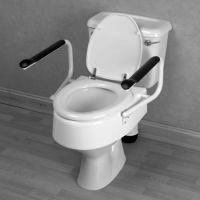
|
Bathtub Transfer Bench and Grab Bars |
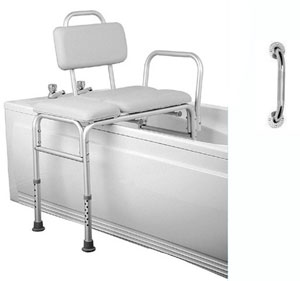
|
Shoe Horn |
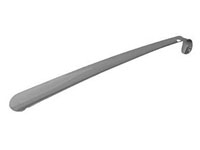
|
Reacher and Sock Aid |

|
Tips for a Safe Home
If your hip fracture was caused by a fall, it’s important for you to look at ways to stop yourself from falling again. To learn more about your risk of falling, and how to prevent further falls, read
Preventing Slips, Trips and Falls.
Things to consider:
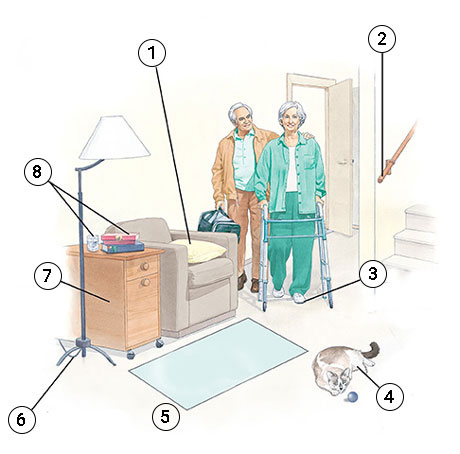
Source: https://www.mountnittany.org/articles/healthsheets/205
Look at the number in the picture above and read below for tips to prevent slips, trips and falls.
- Add a firm pillow to a low chair.
- Install a rail along one side of the staircase.
- Wear rubber-soled shoes to prevent slipping.
- Watch for small pets or objects on the floow.
- Remove throw rugs.
- Move electrical cords out of the way.
- Use a cart to move items.
- Keep items you use often within easy reach.
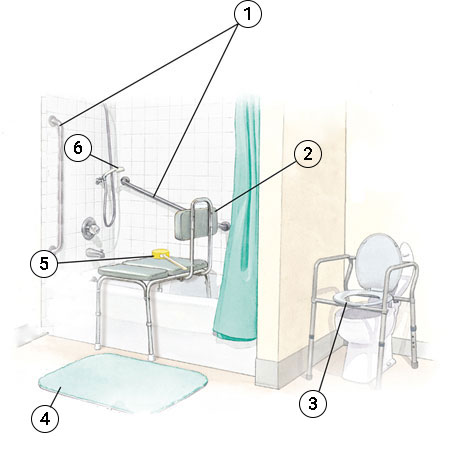
Source: https://www.mountnittany.org/articles/healthsheets/205
Look at the number in the picture above and read below for tips to prevent slips, trips and falls.
- Install grab bars in your shower or tub for support as you get in and out.
- Sit on a bath bench or shower chair while you bathe.
- Use a commode chair or elevated toilet seat to raise the hight of your toilet.
- Use a rubber-backed bathroom mat to help keep the floor dry.
- Use a long-handled sponge to wash hard-to-reach areas.
- Install a hand-held shower head for easier bathing.
Things to Know Before Discharge
Caring for Yourself
- Do your Phase 1 and Phase 2 exercises
- Don’t drive until your doctor says you can. To drive safely, your leg and hip muscles and your reflexes need to be as good as before your hip fracture. If you’re in an accident, your insurance may not cover you if you aren’t safe to drive.
- Having sex: Don’t have sex for 3 months after your surgery. This is to protect your operated hip until it’s fully healed. For other forms of sexual activity, let your partner take the more active role.
- If you need more support while at home, you can call Home Care Services in your area. You can call Health Link at 811 for more information.
- An OT can come to your home to suggest changes that can make your home safer. If you can’t afford to modify your home or buy equipment you need, call the Alberta Supports Contact Centre to get a copy of the Seniors Information Guide.
This lists programs that help adults live on their own safely.
Medicine
- Learn about the medicine you take: what they’re for, and when and how to take them.
- If your medicine to prevent blood clots is given by a needle, your nurse will make sure that you or your family are comfortable giving the needle.
- Keep taking your calcium and vitamin D supplements.
Diet
To prevent constipation:
- drink enough fluid to keep your urine pale yellow
- eat foods high in fibre like whole vegetables and fruit, whole grains, beans, and lentils
Your body needs protein to build and maintain healthy bones and muscles. Weak muscles can increase your risk of falling.
Most adults need about 1 gram (g) of protein per kilogram (kg) body weight per day for bone health. This means that if you weigh 60 kg, you need 60 grams of protein every day for good bone and muscle health.
Good sources of protein include meat, fish, poultry, tofu, eggs, cheese, and cooked dried beans, peas, or lentils.
Your healthcare team will talk to you if you need to stay on a high protein diet and/or keep taking the nutrition supplement.
Equipment
- Use the equipment your therapist recommend.
- If you’re using a walker, don’t lift or carry anything while walking.
If you need equipment for longer than 6 months, talk to your healthcare provider to see if you’re eligible for mobility aids and assistive equipment through the
Alberta Aids to Daily Living (AADL) program.
Follow-Up
- Your nurse will talk to you about how to care for your incision at home.
- Staples should be taken out 10 to 14 days after surgery. Ask your nurse who should take out your staples.
- Know when, where, and with who your follow-up appointment is.
- Tell your doctor and dentist that you had a fractured hip repair. You may need antibiotics before having another procedure.
When to see your family doctor
See your family doctor is you have:
- chills or a temperature above 38.5 °C
- very bad pain at the operated site
- sudden, sharp pain in your hip
- any changes in drainage from your incision (a lot more, or it’s thick, green, or smells bad)
- more redness, pain, or swelling in either leg
- an incision line that’s separating
- follow-up if you fall
- any questions or concerns
If you have pain in your chest or trouble breathing, call 911.
